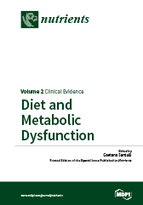Diet and Metabolic Dysfunction
A special issue of Nutrients (ISSN 2072-6643).
Deadline for manuscript submissions: closed (15 February 2016) | Viewed by 424793
Special Issue Editor
2. Department of Advanced Biomedical Science, “Federico II” University, International Translational Research and Medical Education Consortium (ITME), 80131 Naples, Italy
3. Department of Molecular Pharmacology, Albert Einstein College of Medicine, New York, NY 10461, USA
Interests: cardiology; hypertension; restenosis; heart failure; myocardial infarction; endothelial dysfunction; mitochondria; diabetes; microRNAs; insulin resistance; atherosclerosis; thrombosis; cardiac hypertrophy; pancreatic beta cell function; insulin release
Special Issues, Collections and Topics in MDPI journals
Special Issue Information
Dear Colleagues,
The purpose of this Special Issue is to have an updated systematic overview examining in detail the functional role of different diets and dietary components in maintaining glucose homeostasis and prevention of long-term complications. This Special Issue of Nutrients welcomes the submissions of manuscripts which either include evidence-based original research or reviews of the scientific literature.
Dr. Gaetano Santulli
Guest Editor
Manuscript Submission Information
Manuscripts should be submitted online at www.mdpi.com by registering and logging in to this website. Once you are registered, click here to go to the submission form. Manuscripts can be submitted until the deadline. All submissions that pass pre-check are peer-reviewed. Accepted papers will be published continuously in the journal (as soon as accepted) and will be listed together on the special issue website. Research articles, review articles as well as short communications are invited. For planned papers, a title and short abstract (about 100 words) can be sent to the Editorial Office for announcement on this website.
Submitted manuscripts should not have been published previously, nor be under consideration for publication elsewhere (except conference proceedings papers). All manuscripts are thoroughly refereed through a single-blind peer-review process. A guide for authors and other relevant information for submission of manuscripts is available on the Instructions for Authors page. Nutrients is an international peer-reviewed open access semimonthly journal published by MDPI.
Please visit the Instructions for Authors page before submitting a manuscript. The Article Processing Charge (APC) for publication in this open access journal is 2900 CHF (Swiss Francs). Submitted papers should be well formatted and use good English. Authors may use MDPI's English editing service prior to publication or during author revisions.
Keywords
- Lifestyle and genetics
- Diets: Mediterranean, Vegan/Vegetaria
- Mitochondria and redox balance (antioxidants)
- Biomarkers including miRNAs
- Soft drinks, sweetened beverages, soda, fructose
- Probiotics, nutraceuticals, soy, seaweed polyphenols
- Beta cell function and insulin secretion
- Dietary fiber
- Gluten sensitivity
- Aging, metabolic syndrome and cardiovascular disease







